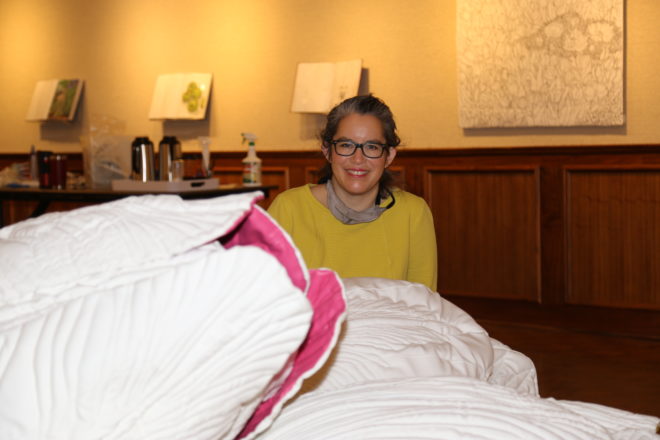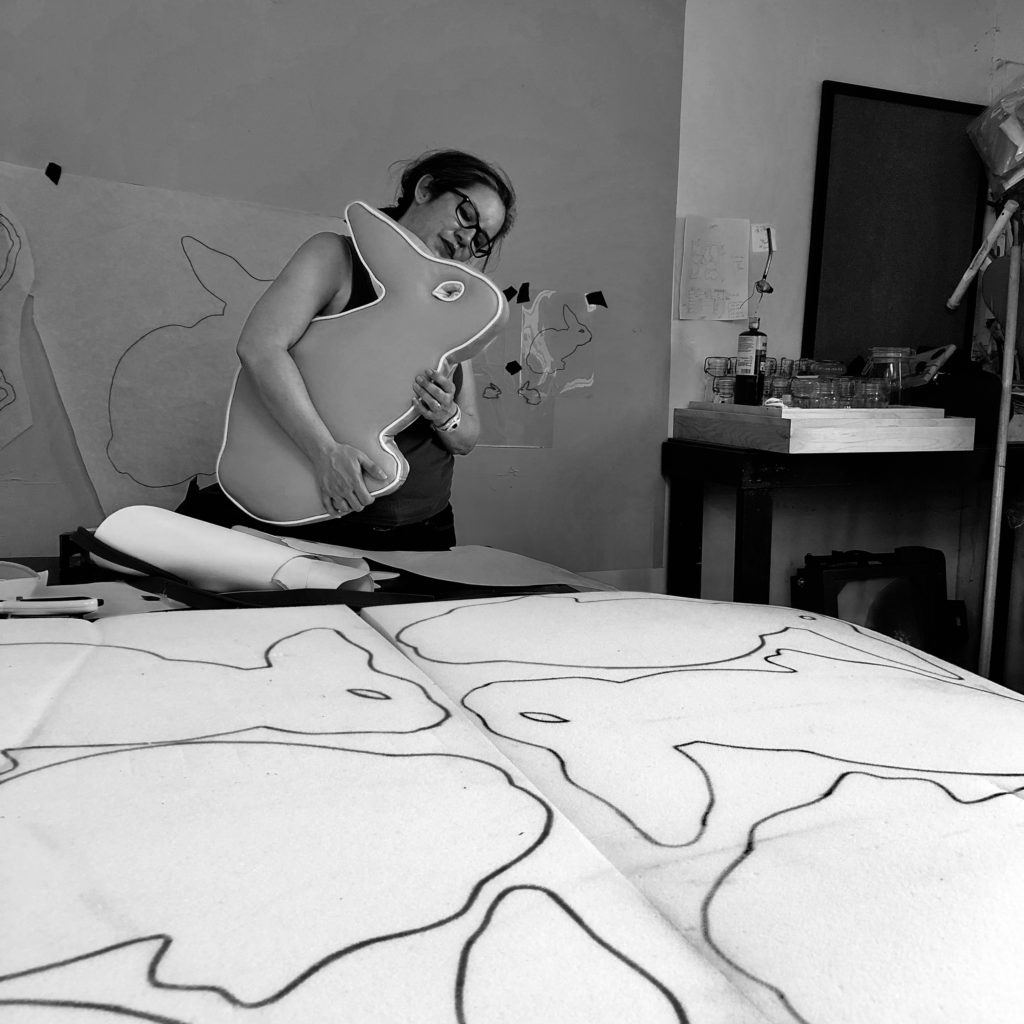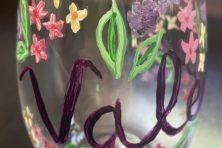A Calling to Create
- Share
- Tweet
- Pin
- Share

Leslie Iwai brings her 3D art to life at the Miller Art Museum
The Miller Art Museum has a dramatically different look courtesy of new work by Leslie Iwai, an artist who does installations, often involving fabric. Her new installation, called Winter’s Spring: An Ältere Garten by Leslie Iwai, opened Oct. 24 and will run through Dec. 26.
On the floor of the Miller are five white, vinyl tulips (the only color is inside the bulbs) that are 17-20 feet long. The stems are wrapped in more vinyl and zippered shut – she buys zippers in rolls – and the leaves are quilted. The grand piano has been moved, and the room has no furniture past the entry desk and bookstore.
The back wall’s alcove has been covered with a flat, white wall that holds a rabbit hutch: a rectangular frame filled with stuffed rabbits in profile that Iwai has designed and sewn. A flock of birds swoops along the wall, starting with a dark shape at dusk and sweeping through the night to sunrise.

“It uses the Miller space in such a different way,” said Helen del Guidice, the Miller Art Museum curator who worked with Iwai to develop and refine the concepts. To complement the installation, del Guidice has hung the museum’s mezzanine level with botanicals and pictures of birds.
“The entire museum is involved with what is going on down here,” del Guidice explained. “It brings all of the museum into the exhibit.”
Iwai’s educational background is unusual for an artist: She studied math and chemistry as an undergrad and then earned a master’s degree in architecture at Virginia Tech. Her studies were modeled after the Bauhaus, which was known for blending artistic and craft disciplines.
“Then they threw us into woodshop, metal shop, ceramics, printmaking, photography – all in the architecture department, not the art department,” Iwai said.
She now lives in Middleton, Wisconsin, where she makes art and teaches.
Iwai likes the sense of impermanence of an installation – impermanence that means that much of her work exists only as photographs of past installations, much as Christo’s fabric fences and wraps exist now only as photographs, videos and drawings.

“An installation is this sense of holding something beautiful so you can look at it because you know it’s going to go away,” Iwai said. “This is captivating to me. Except when I have to drag around all my pieces and pack them and store them someplace,” she added – probably with a smile, but under her mask, it was hard to tell. “But no, I love the sense of something just kind of appearing in a space and changing the whole space.”
In her blog, Iwai writes: “For me, the process of creating each new work follows a similar course. I discover a narrative, commence working out its expression through physical materials, which culminates in the inevitable intensity of bringing it to form and completion.”
Installations such as the one at the Miller, which took place during three days, often get frenetic toward the end, and Iwai writes of “taking time to Sabbath – to be still and know that my life and practice are not my own – connects me to our compassionate God, the One who loves my creative mess, who brings me peace, joy and comfort, even as my independent self often wants to clean up right away and move on.”

Asked about the spiritual dimension of her work, Iwai said, “I am a Christian. I feel like art wants to be made, and I get the joy and pleasure of making it, so I’m sort of a co-author. I feel that artwork has a life of its own, and I’m called to create. I feel like my vocation is to bring things to life that are already just floating around.”
The back room has photographs of a variety of her installations and some intriguing drawings from Sierra Leone.
“I had people sketch me,” Iwai said, “and then I drew them back. So you can see different drawings of how people drew me and how I drew them. This is sort of about face-to-face interactions. It’s not photographing someone; it’s actually getting to know them through looking at each other and drawing each other.”
Iwai has hung the sketches, created on Mylar, with her drawing on top, and then behind it, the other person’s drawing of her, which creates a shadowy existence.
She’s also exhibiting designs made with layers of fabric, constructions made from a single sheet of folded paper and held inside a glass tube, a small light box with more designs, and intriguing, three-dimensional wall sculptures made by running fishing line through aluminum screening.
Iwai revels in detail. A quilted giraffe, about three feet tall, took 50 hours to design and 100 to craft, she said.
“I like pattern-making,” Iwai said of her creation. The giraffe has zippers on each leg and another on his body, along with a steel armature and little caps for his legs.
“You know,” she said, “he doesn’t like me to take his tail up – that’s kind of embarrassing.”
The museum – located inside the Door County Library, 107 S. 4th Ave. in Sturgeon Bay – is open Monday, 12-7 pm; Thursday and Friday, 10 am – 5pm; and Saturday, 10 am – 1 pm. Admission is free, but donations are encouraged. An elevator is available to reach the galleries on the Ruth Morton Miller Mezzanine. To learn more about the exhibit or museum, call 920.746.0707 or visit millerartmuseum.org.



